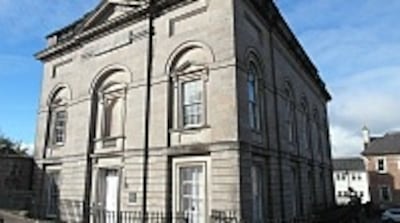The tradition of applying classical lettering to buildings is an ancient one. The Pantheon in Rome carries a (misleading) inscription to Agrippa. My favourite inscription, for its bombast, is on the facade of San Giovanni in Laterano – “omnium urbis et orbis ecclesiarum mater et caput” (mother and head of all the churches of the city and of the world).
The inscription on the front of the Armagh Robinson Library, in Greek, implies a more engaging welcome: it offers readers therapy for the mind.
The library last year celebrated the 250th anniversary of its foundation by Archbishop Richard Robinson.
Robinson's contribution to Armagh is traditionally compared to Augustus's legendary turning of Rome from a city of brick into one of marble. Anthony Malcomson's biography of Robinson, in pointing to his self-interest and to how little his patronage cost him personally, is more critical. But Robinson certainly increased the consequence of the city by removing to it from Drogheda the Archbishop's palace; he founded the Armagh Observatory; he left money in his will for the foundation of a university in the city. And in 1771 he founded – on the model of Archbishops Marsh in Dublin and Bolton in Cashel – what is now the Armagh Robinson Library.
Had Robinson not ordered the destruction of his papers and correspondence, we might have learned more about his colourful brother
His architect for the building was Thomas Cooley, then erecting the spectacular Royal Exchange (now the City Hall) in Dublin.
But Robinson had little time it seems for such references to fashionable Roman architecture. He kept Cooley on a tight leash in the humdrum buildings in which they were both involved.

The present library is a distinguished and beautifully detailed building, but this is largely due to the extension and alterations in 1845 to Cooley's original building. This later work was to the designs of the Dublin architect Robert Law Monsarrat who died in his late twenties.
Had Robinson not ordered the destruction of his papers and correspondence, we might have learned more about his colourful brother, the amateur architect Sir Thomas, whom Malcomson calls "the mad Palladian".
The wing he added to Castle Howard in Yorkshire when he was commissioned to complete Vanbrugh’s sublime building can be reasonably described as tactless.
There is a terrible story about his importuning the leading British Palladian, Lord Burlington. His unwelcome visits to Burlington House in Piccadilly resulted in the frequent advice that Lord B was not at home.
Undeterred, Sir Thomas would ask for admission to enter the hall to view the clock or to look at the pet monkey in the hope that his lordship might appear. Eventually, the porter at the gate was instructed to tell him that Lord Burlington was out, the clock was stopped, and the monkey was dead.
Whatever his other eccentricities, Thomas's books form one of the richest architectural libraries in the country
The Robinsons came from Rookby (later gentrified as Rokeby) in Yorkshire where Sir Thomas had designed one of the most interesting smaller Palladian houses in England. When ennobled as a baron,the Archbishop took the title Rokeby of Armagh. And the private house which he built in Co Louth he called Rokeby Hall. (Velazquez's famous Rokeby Venus in the National Gallery in London once hung in the Yorkshire house but after the house had been sold by the impecunious and spendthrift Sir Thomas).
Thomas (“a specious empty man, and a great pest to persons of high rank”) was a picturesque figure who probably embarrassed the Archbishop, who successfully frustrated his brother’s request in his will that his correspondence be published. But Armagh is still greatly indebted to the “mad Palladian” because he bequeathed to his brother whichever of his books on architecture and antiquities the archbishop might want for his new library.
Whatever his other eccentricities, Thomas’s books form one of the richest architectural libraries in the country and testify to his passionate interest in the subject. Curiously, the Archbishop may have been a little jealous of his brother’s eminence as collector – Richard’s own bookplate is only half the story of ownership in those cases where Thomas’s survives, but covered up.
These books survive along with the other treasures of the Robinson Library – books from the earliest period of European printing; Swift's copy of Gulliver's Travels with his own annotations; books that are not in the British Library, or Trinity College, or the National Library; the surviving books of the great 17th-century library of Viscount Conway, long thought to have been destroyed in the rebellion of 1641. And this Wunderkammer has more than books.
Its prehistoric antiquities, its 12th-century manuscripts, its architectural drawings including Thomas Cooley's models for parish churches, its prints (a near-complete set of Piranesi), its 3,000 "gems" by James Tassie, its sulphur casts from 1689-97 of Louis XIIV medals, all constitute an oasis – rare in Ireland – which promises and offers "therapy for the mind".







